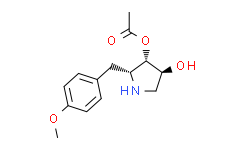| Cas No.: | 22862-76-6 |
| Chemical Name: | Anisomycin |
| Synonyms: | 3,4-Pyrrolidinediol,2-[(4-methoxyphenyl)methyl]-, 3-acetate, (2R,3S,4S)-;Anisomycin;Anisomycin from Streptomyces griseolus;Anisomycin,(2R,3S,4S)-2-[(4-Methoxyphenyl)methyl]-3,4-pyrrolidinediol3-acetate;(2R,3S,4S)-2-(4-Methoxybenzyl)-3,4-pyrrolidinediol 3-Acetate;2-p-methoxyphenylmethyl-3-acetoxy-4-hydroxypyrrolidine;ANISOMYCIN,STREPTOMYCES GRISEOLUS;antibioticpa-106;Wuningmeisu C;Flagecidin;(-)-Anisomycin;(2R,3S,4S)-2-(p-Methoxyphenylmethyl)-3-acetoxy-4-hydroxypyrrolidine;NSC 76712;(2R,3S,4S)-4-hydroxy-2-(4-methoxybenzyl)pyrrolidin-3-yl acetate;NSC76712;(2R,3S,4S)-2-(p-Methoxybenzyl)-3,4-pyrrolidinediol 3-acetate;Upjohn 204t3;2-(p-Methoxybenzyl)-3,4-pyrrolidinediol 3-acetate;6C74YM2NGI;MLS001066392;Anisomycin, Streptomyces griseolus;1,4,5-Trideoxy-1,4-imino-5-(p-methoxyphenyl)-D-xylo-pentitol 3-acetate;SMR00047 |
| SMILES: | O(C(C([H])([H])[H])=O)[C@]1([H])[C@]([H])(C([H])([H])N([H])[C@]1([H])C([H])([H])C1C([H])=C([H])C(=C([H])C=1[H])OC([H])([H])[H])O[H] |
| Formula: | C14H19NO4 |
| M.Wt: | 265.305 |
| Sotrage: | 2 years -20°C Powder, 2 weeks 4°C in DMSO, 6 months -80°C in DMSO |
| Description: | Anisomycin is a potent protein synthesis inhibitor which interferes with protein and DNA synthesis by inhibiting peptidyl transferase or the 80S ribosome system. |
| In Vivo: | Disruption of TNFRp55/p75 attenuates Anisomycin-induced ventricular functional improvements. Anisomycin results in an improvement in left ventricular developed pressure (LVDP), which disappears in animals with disruption of TNFR p55/p75. In addition, the Anisomycin-induced improvement in LVEDP in wild-type animals is eliminated by deletion of TNFR p55/p75. Likewise, disruption of TNFR p55/p75 abrogates the recovery of rate pressure product (RPP) elicited by pretreatment of Anisomycin. TNFR p55/p75-/- mice without Anisomycin treatment do not show differences in cardiac functional recovery compared with the control wild-type mice. There are no significant differences in heart rate between wild-type and TNFR p55/p75-deficient mice. To see whether Nox2 is involved in Anisomycin-induced myocardial protection, Nox2-deficient mice are treated with Anisomycin. The improvement in the LVEDP in Anisomycin-treated mice is eliminated in Nox2-/- mice compared with wild-type mice. In addition, recovery of RPP in wild-type mice treated with Anisomycin is mitigated in Nox2-/- mice. Nox2-/- mice without Anisomycin treatment do not show the difference in cardiac functional recovery compared with wild-type control mice[2]. |
| In Vitro: | To examine whether JNK has a core role in colistin-induced neurotoxicity in PC-12 cells, an SP600125 (a highly selective inhibitor of JNK) and Anisomycin (a potent activator) are used in this study. In order to select an appropriate concentration, PC-12 cells are treated with a range of SP600125 (0-80 μM) and Anisomycin (0-20 μM) respectively for 24 h. The results show that the cells viability significantly decreases by SP600125 treatment in a concentration-dependent manner, observed at the concentrations greater than 20 μM (p<0.01). Similarly the cells viability is inhibited by Anisomycin treatment (≥8 μM) (p<0.05) [1]. |

 DC Chemicals' products qualify for U.S. tariff exemptions. We guarantee no price increases due to customs duties and maintain stable supply, continuing to deliver reliable research solutions to our American clients.
DC Chemicals' products qualify for U.S. tariff exemptions. We guarantee no price increases due to customs duties and maintain stable supply, continuing to deliver reliable research solutions to our American clients.





















